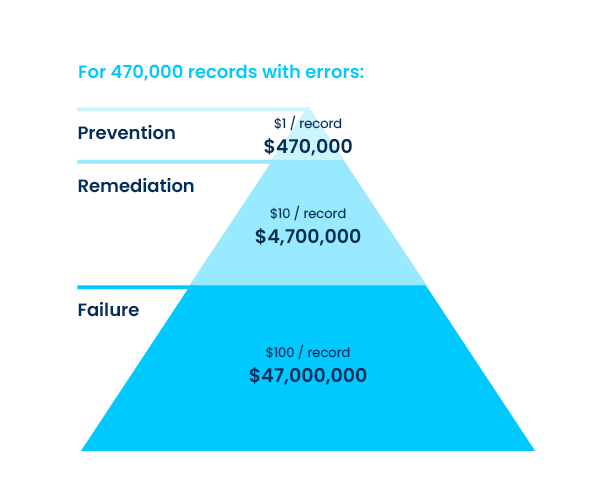The 1-10-100 Rule pertains to the cost of bad quality. As digital transformation is becoming more and more prevalent and necessary for businesses, data across a company is integral to operations, executive decision-making, strategy, execution, and providing outstanding customer service. Yet, many enterprises are plagued by having data that is completely riddled with errors, duplicate records containing different information for the same human customer, different spellings for names, different addresses, more than one account for the same vendor (where pricing is not consistent), inconsistent information about a customer’s lifetime value or purchasing history, and reports and dashboards are often not trusted because the data underlying the display is not trusted. By its very nature, business operations often include manual data entry and errors are inherent.
The true cost to an organization of trying to conduct operations and make decisions based upon data riddled with errors is tough to calculate. That’s why G. Loabovitz and Y. Chang set out to conduct a study of enterprises to measure the cost of bad data quality. The 1-10-100 Rule was born from this research.

The Harvard Business Review reveals that on average, 47% of newly created records contain errors significant enough to impact operations.
If we combine the 1-10-100 Rule, using $100 per record for failing to fix data errors, with the Harvard Business Review statistic on the volume of such errors typical for an organization, the cost of poor data quality adds up rapidly. For an enterprise having 1,000,000 records, 470,000 have errors each costing the enterprise $100 per year in opportunity cost, operational cost, etc. This costs the enterprise $47,000,000 per year. Had the enterprise cleansed the data, the data clean-up effort would have cost $4,700,000 and had the records been verified upon entry, the cost would have been $470,000. Inherit in business services are errors caused by human manual data entry. Even with humans eyeballing records as they are entered, errors escape. This is why investing in an automated data management platform with built-in data quality provides a huge cost savings to an organization. Our solution, Aunsight Golden Record, can help organizations mitigate these data issues by automating data integration and cleansing.
